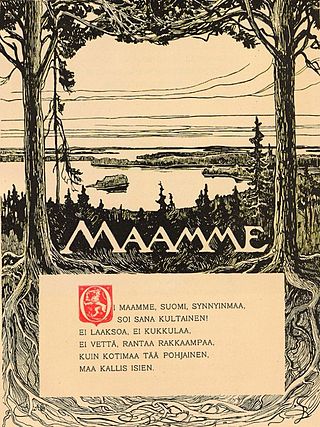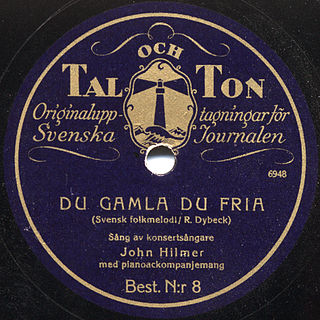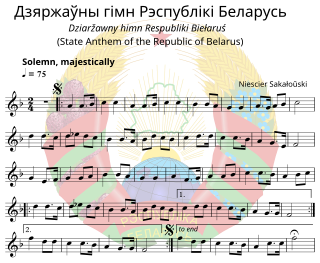An anthem is a musical composition of celebration, usually used as a symbol for a distinct group, particularly the national anthems of countries. Originally, and in music theory and religious contexts, it also refers more particularly to short sacred choral work and still more particularly to a specific form of liturgical music. In this sense, its use began c. 1550 in English-speaking churches; it uses English language words, in contrast to the originally Roman Catholic 'motet' which sets a Latin text.

"God Save the King" is the national anthem of the United Kingdom and the royal anthem of each of the British Crown Dependencies, one of two national anthems of New Zealand, and the royal anthem of most Commonwealth realms. The author of the tune is unknown and it may originate in plainchant, but an attribution to the composer John Bull has sometimes been made.
"O Canada" is the national anthem of Canada. The song was originally commissioned by Lieutenant Governor of Quebec Théodore Robitaille for the 1880 Saint-Jean-Baptiste Day ceremony; Calixa Lavallée composed the music, after which French-language words were written by the poet and judge Sir Adolphe-Basile Routhier.

"The Star-Spangled Banner" is the national anthem of the United States. The lyrics come from the "Defence of Fort M'Henry", a poem written on September 14, 1814, by 35-year-old lawyer and amateur poet Francis Scott Key after witnessing the bombardment of Fort McHenry by British ships of the Royal Navy in Outer Baltimore Harbor in the Patapsco River during the Battle of Baltimore in the War of 1812. Key was inspired by the large U.S. flag, with 15 stars and 15 stripes, known as the Star-Spangled Banner, flying triumphantly above the fort during the U.S. victory.
"Land of Hope and Glory" is a British patriotic song, with music by Edward Elgar, written in 1901 and with lyrics by A. C. Benson later added in 1902.

"Maamme" is the de facto national anthem of Finland. The music was composed by the German immigrant Fredrik Pacius, with original Swedish lyrics by Johan Ludvig Runeberg. It was first performed with the current melody and lyrics on 13 May 1848. Originally, it was written for the 500th anniversary of Porvoo, and for that occasion it was Runeberg himself who wrote the music.

"Du gamla, du fria" is the de facto national anthem of Sweden. It was originally named "Sång till Norden", but the incipit has since been adopted as the title.
The Finlandia hymn refers to a serene hymn-like section of the patriotic symphonic poem Finlandia, written in 1899 and 1900 by the Finnish composer Jean Sibelius. It was later re-worked by the composer into a stand-alone piece. With words written in 1940 by Veikko Antero Koskenniemi, it is one of the most important national songs of Finland. Although not the official national anthem of Finland, it has been continuously proposed as such.

The "State Anthem of the Republic of Belarus", better known as "My Belarusy", is the national anthem of Belarus. It was originally written in the 1940s and adopted in 1955 for use in the Byelorussian Soviet Socialist Republic. The music of the Byelorussian SSR's regional anthem was composed by Niescier Sakałoŭski and the lyrics were written by Michas Klimkovič. After the dissolution of the Soviet Union, the music composed by Sakalowski was kept and the lyrics were discarded. New lyrics, which were written by Klimkovič and Uladzimir Karyzna, were adopted by a presidential decree issued on 2 July 2002.

"On Ilkla Mooar Baht 'at" is a folk song from Yorkshire, England. It is sung in the Yorkshire dialect, and is considered the unofficial anthem of Yorkshire. It is sung to the hymn tune "Cranbrook", composed by Thomas Clark in 1805; while according to Andrew Gant, the words were composed by members of Halifax Church Choir "some 50 years after Clark wrote his melody", on an outing to Ilkley Moor near Ilkley, West Yorkshire. It is classified as numbers 2143 and 19808 in the Roud Folk Song Index.

Samuel Francis Smith was an American Baptist minister, journalist, and author. He is best known for having written the lyrics to "My Country, 'Tis of Thee", which he entitled "America".

"Heil dir im Siegerkranz" was the Kaiserhymne of the German Empire from 1871 to 1918 and royal anthem of Prussia from 1795 to 1918.

"O Tannenbaum", known in English as "O Christmas Tree", is a German Christmas song. Based on a traditional folk song that was unrelated to the holiday, it became associated with the traditional Christmas tree.

"Columbia, the Gem of the Ocean" is an American patriotic song which was popular in the U.S. during the 19th and early 20th centuries. Composed c. 1843, it was long used as an unofficial national anthem of the United States, in competition with other songs. Under the title "Three Cheers for the Red, White, and Blue," the song is mentioned in Chapter IX of MacKinlay Kantor's Pulitzer Prize-winning novel Andersonville (1955). It was also featured in the 1957 musical The Music Man. In 1969, "Columbia, the Gem of the Ocean" was the music performed by a U.S. Navy Band embarked aboard USS Hornet as one of the ship's helicopters recovered the Apollo 11 astronauts from their capsule named Columbia after a splashdown in the Pacific Ocean.

"Simple Gifts" is a Shaker song written and composed in 1848, generally attributed to Elder Joseph Brackett from Alfred Shaker Village. It became widely known when Aaron Copland used its melody for the score of Martha Graham's ballet, Appalachian Spring, premiered in 1944.

American patriotic music is a part of the culture and history of the United States since its foundation in the 18th Century. It has served to encourage feelings of honor both for the country's forefathers and for national unity. They include hymns, military themes, national songs, and musical numbers from stage and screen, as well as others adapted from many poems. Much of American patriotic music owes its origins to six main wars — the American Revolution, the American Indian Wars, the War of 1812, the Mexican–American War, the American Civil War, and the Spanish–American War. During the period prior to American independence, much of the country's patriotic music was aligned with the political ambitions of the British in the new land. And so, several songs are tied with the country's British origin.
In vocal music, contrafactum is "the substitution of one text for another without substantial change to the music". The earliest known examples of this procedure date back to the 9th century used in connection with Gregorian chant.

"Rufst du, mein Vaterland" is the former national anthem of Switzerland. It had the status of de facto national anthem from the formation of Switzerland as a federal state in the 1840s, until 1961, when it was replaced by the Swiss Psalm.

"God Defend New Zealand" is one of two national anthems of New Zealand, the other being "God Save the King". Legally the two have equal status, but "God Defend New Zealand" is more commonly used. Originally written as a poem, it was set to music as part of a competition in 1876. Over the years its popularity increased, and it was eventually named the second national anthem in 1977. It has English and Māori lyrics, with slightly different meanings. Since the late 1990s, the usual practice when performed in public is to perform the first verse of the national anthem twice, first in Māori and then in English.

"Hear my prayer, O Lord", Z. 15, is an eight-part choral anthem by the English composer Henry Purcell (1659–1695). The anthem is a setting of the first verse of Psalm 102 in the version of the Book of Common Prayer. Purcell composed it c. 1682, at the beginning of his tenure as Organist and Master of the Choristers for Westminster Abbey.

















